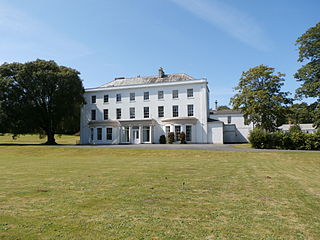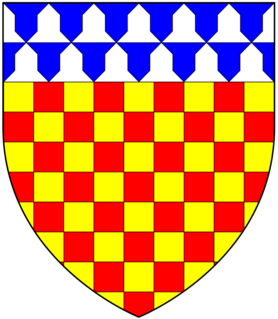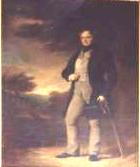
Baron Poltimore, of Poltimore in the County of Devon, is a title in the Peerage of the United Kingdom. It was created in 1831 for Sir George Bampfylde, 6th Baronet. His son, the second Baron, held office as Treasurer of the Household from 1872 to 1874 in the first Liberal administration of William Ewart Gladstone.

There have been three baronetcies created for persons with the surname Croft, one in the Baronetage of England and two in the Baronetage of the United Kingdom. All three creations are extant as of 2008.

Moreton House is a grade II listed country house and former large estate near Bideford, North Devon, England. The house is about one mile west of the old centre of Bideford town, its entrance drive leading off the south side of the road between Bideford and the village of Abbotsham. It has in recent years become increasingly surrounded by the suburbs of Bideford, and in 2014 only 5 acres of the former parkland remain attached to the house. The estate is said anciently to have been the property of the famous Grenville family, lords of the Manor of Bideford, and of Stowe, Kilkhampton in Cornwall. It was later acquired by the Buck merchant family of Bideford, which rebuilt the house in 1760 and again in 1821.

Sir Richard Warwick Bampfylde, 4th Baronet of Poltimore, North Molton, Warleigh, Tamerton Foliot and Copplestone in Devon and of Hardington in Somerset, England, was Member of Parliament for Exeter (1743–47) and for Devonshire (1747–76).
There have been two baronetcies created for persons with the surname Cave, one in the Baronetage of England and one in the Baronetage of the United Kingdom. Both creations are extant as of 2008.

George Warwick Bampfylde, 1st Baron Poltimore, of Poltimore, Devon, known from 1823 to 1831 as Sir George Bampfylde, 6th Baronet, was a British peer.

There have been three baronetcies created for persons with the surname Chichester, one in the Baronetage of England and two in the Baronetage of the United Kingdom. Only the 1641 creation is extant.

There have been two baronetcies created for members of the Peto family, both in the Baronetage of the United Kingdom. As of 2014 both creations are extant.
There have been three baronetcies created for persons with the surname Newman, one in the Baronetage of England and two in the Baronetage of the United Kingdom. Two of the creations are extant as of 2007.
Colonel Sir George Stucley Stucley, 1st Baronet, known as George Buck until 1858, was a British Conservative Member of Parliament.
There have been three baronetcies created for persons with the surname Pole, one in the Baronetage of England, one in the Baronetage of Great Britain and one in the Baronetage of the United Kingdom. Two of the creations are extant as of 2008.
The Colthurst Baronetcy, of Ardrum in the County of Cork, is a title in the Baronetage of Ireland. It was created on 3 August 1774 for John Colthurst, who represented Doneraile, Youghal and Castle Martyr in the Irish House of Commons. The third Baronet was a member of the Irish Parliament for Longford and Castle Martyr. The fourth Baronet represented Cork City in the British House of Commons from 1812 to 1829. The fifth Baronet sat as Liberal Member of Parliament for Kinsale between 1863 and 1874. The sixth Baronet served as High Sheriff of County Cork. The eighth Baronet was High Sheriff of County Dublin. Since 2003 the title has been held by his grandson, the tenth Baronet.

Sir Charles Warwick Bampfylde, 5th Baronet of Poltimore in Devon, was a British politician who served twice as Member of Parliament for Exeter, in 1774–1790 and 1796–1812.

Sir Coplestone Bampfylde, 2nd Baronet of Poltimore and North Molton and Warleigh, Tamerton Foliot, in Devon, was an English politician who sat in the House of Commons at various times between 1659 and 1689.

George Wentworth Warwick Bampfylde, 4th Baron Poltimore (1882–1965) of Poltimore and North Molton, Devon, was a peer and major landowner in Devonshire, whose family had been seated at Poltimore from about 1300. He was a Justice of the Peace for Devon and occupied the honorary position of High Steward of South Molton, Devon.

Lewis William Buck (1784–1858) of Moreton House, Bideford, and Hartland Abbey, Devon, was Member of Parliament for Exeter 1826–32 and for North Devon 1839–57, and was Sheriff of Devon in 1825/6. A full-length portrait of Lewis William Buck by Francis Grant (1803–1878) was presented to him by the people of North Devon after he had served eighteen years as their MP, now displayed in the billiards room of Hartland Abbey, with his electioneering posters on each side.

Affeton is a former historic manor in Devon. It was at one time also a parish with its own parish church, but was later merged into the parish of West Worlington. The manor house was almost entirely demolished in the Civil War, the only part left standing was the gatehouse, which fell into ruin. A large farmhouse known as "Affeton Barton" was soon after built over the foundations and cellars of the manor house. The ruinous gatehouse was converted in 1868-9 to a shooting box for the use of the Stucley family of Hartland Abbey and Moreton House, Bideford, and became known thereafter as "Affeton Castle".

The Manor of Poltimore is a former manor in Devon, England. The manor house known as Poltimore House survives in its 18th-century remodelled form, but has been dilapidated for several decades. A charity named the "Poltimore House Trust" has been established for the purpose of its restoration. The manor was situated within the historic Wonford Hundred and was largely coterminous with the parish of Poltimore and contained the village of Poltimore, 4 miles (6.4 km) north-east of the historic centre of the City of Exeter. It should not be confused with the eponymous Devon estate of Poltimore in the parish of Farway, 16 miles (26 km) east of Exeter. Poltimore was the principal seat of the Bampfylde family from c. 1300 to 1920.

Sir Hugh Stucley (1496–1559) was lord of the manor of Affeton in Devon, and was Sheriff of Devon in 1545. His third son was Thomas Stukley, known as "The Lusty Stucley".









